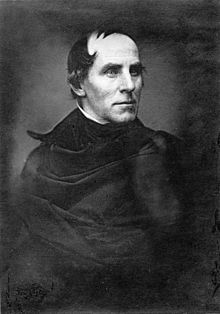
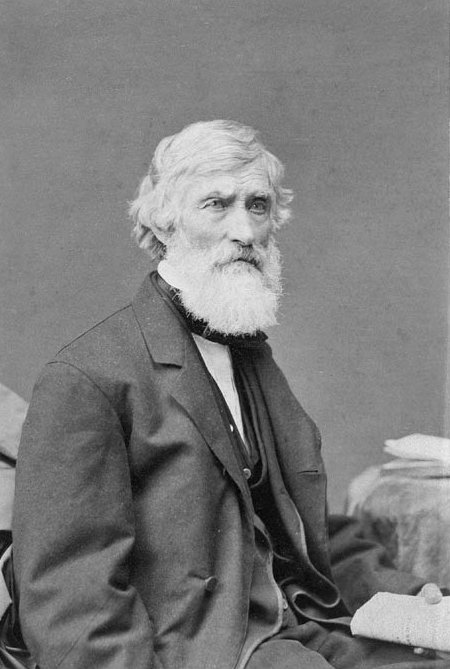
In this post I am going to be discussing American art in the 1850’s and 1860’s. I will be leaving the Renaissance period but will come back to it at a later stage. The Hudson School of River painting which emerged in the United States has often been overlooked in favour of the great Landscape artists in France and England particularly Claude Lorrain and JMW Turner.
Art critics have been unfair to this emerging tradition of Landscape painting and I propose to correct that situation by concentrating on American Art from this period through to the Emergence of Abstract art in the twentieth Century. It was America that was to be the leader in all aspects of Art in the Twentieth Century so it is worthwhile concentrating on the early development of American artistic practices.
I will first consider Thomas Cole who was the first of these great artists. it can be argued that Cole founded the Hudson River school of Painting.
” Cole is considered the leading painter of the Hudson River school. this group of painters who worked mainly around New England were fond of river and mountain scenes untouched by Man”. [1].
” Cole aimed to bring religious and moral meaning to his paintings. he once wrote that the wilderness is yet a fitting place to speak of God”. [2].
Cole was well travelled like a number of artists in the USA he travelled widely mainly in Europe.
” He visited England , France and Italy but he was not impressed by what he saw. His paintings had a strong Romantic quality full of Drama and Grandeur”. [3].
The last painter I am going to discuss in Part 2 will be Frederick E Church who again like Cole really was inspired by nature and the Landscape of the united States.
” Church has revealed the power of nature in all its glory. The only pupil of Thomas Cole Church chose to banish man from his compositions and concentrate on nature in its purest state”. [4].
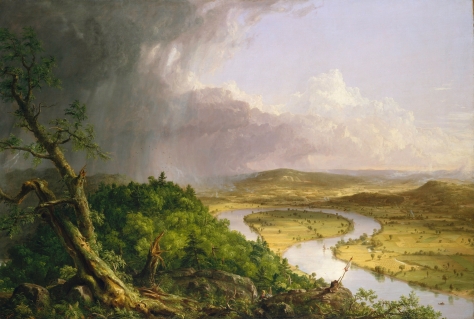


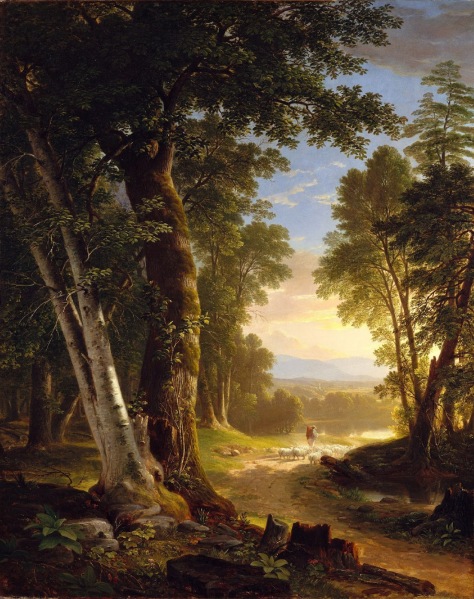
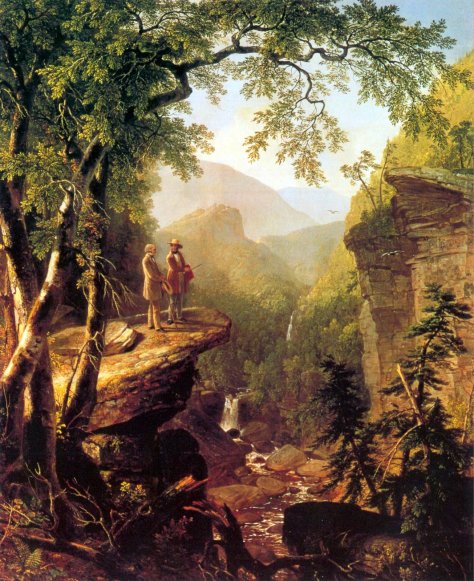
The Art Book considers the importance of Church and the places he sought for Inspiration.
” After exploring his native New England he went in search of dramatic and panoramic landscapes further afield. Unusually for the time he did not choose Europe. instead he explored the American Continent , the volcanoes of Mexico, the typical jungles of south America , the snow covered peaks of the Andes and the Icebergs of Labrador”. [5].
Robert Atkins in Art Spoke refers to Luminism which was thought to be a part of the Hudson School of painting.
” Luminism is sometimes considered an offshoot of the final phase of Hudson River School Painting”. [6].
” But Luminism’s frequent use of misty light, stabilising horizontal bands of compositional organisers and invisible brushwork distinguish it from the often brashly theatrical painting by the River school painters such as Albert Bierstadt and Frederick Edwin Church”. [7].
Other European artists we should consider who had a great influence on the River school painters is Caspar David Frederick whose landscapes had that eerie and isolated feel to his Romantic imagery.
” The eerie poetic landscapes by Caspar David Frederick contrast vividly with the brash , sharply focused observation of paintings by Frederick Edwin Church which proclaimed the United states divinely ordained manifest destiny”. [8].
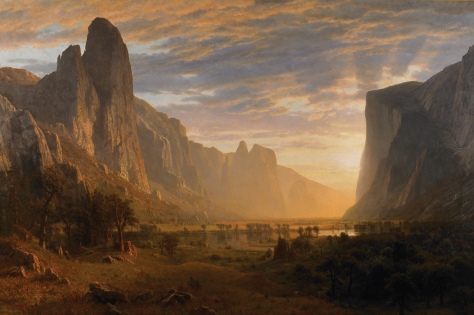
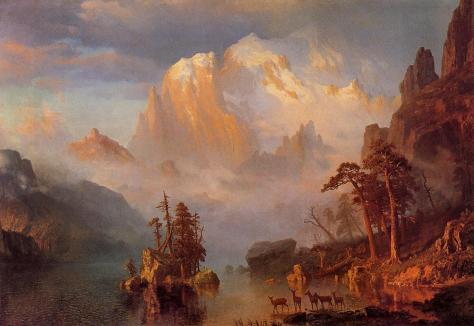

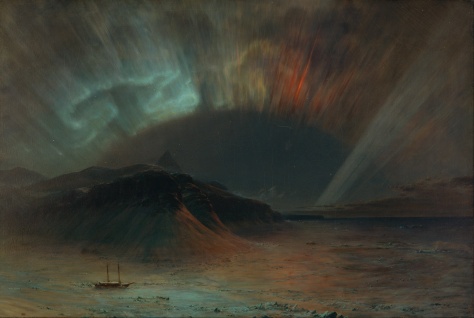

The main discussions at these times was whether Landscape paintings could aspire to the highest Genre of History Paintings or they just remained Landscape or Genre paintings.
” the difference of opinion between artists wanting to create imaginative Landscape paintings or even elevate This category to the level of history painting and patrons who preferred realistic views of nature is a leitmotif that runs through the career of Thomas Cole”.[9].
Matthew Baigell in his Concise History of American painting comments on the comparison between Cole and Claude Lorrain in considering their compositional virtues.
” Despite the fact that Cole often used the compositional formula’s of Claude Lorrain as well as the dramatic ones of Salvador Rosa he was probably the first artist in America to suggest the actual, physical emotional and visual experience of being in the Wilderness”. [10].
” A native of England Cole came to the united States in his teens. Evidently possessing great talent Cole began to use landscapes as a dramatic foil in works such as the Garden of Eden and expulsion from the garden of Eden”.[11].
Baigell begins to explain about the two great cycles of work that Cole completed around the theme of Empire.
” Instead his two greatest cycles dealt with separate parts of his this Theme The course of Empire (1833-6)”.[12].
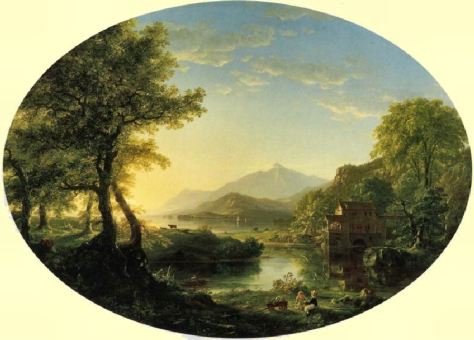


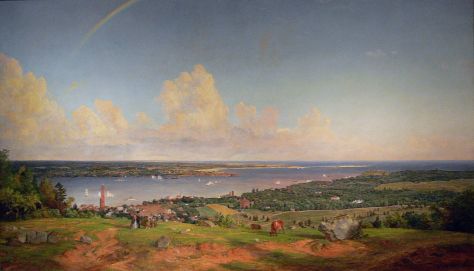

Matthew Baigell continuing his commentary on Cole’s importance as a truly American artist describes his prodigious talent and expertise.
” Cole’s interest in painting cycles qickened while he was abroad from 1829-1832 probably the panoramas he saw in England reinforced the ides of painting in a series and his ruminations in Italy on the passage of civilisations”. [13].
” Although Cole like other landscapists took great pleasure in Hiking in the woods and studying nature directly he began to paint less as one experiencing the outdoors at first hand and more as one who enjoys it in retrospect”.[14].
This description of Hiking and observing nature and the landscape as first hand was common among English water colourists like Samuel Palmer , John Girtin , Constable and Turner himself who all enjoyed the beautiful lush landscape in Lancashire and Yorkshire. Many of the Romantic poets like Coleridge Byron Shelley and Wordsworth would have inspired Turner and his contemporaries.
Referring to Cole Baigell invests him together with Church as one of the two most important painters in the River school of painting.
” No other Painter (Thomas Cole) of the time reflected so clearly the paradoxes of American society- the sense of gratitude for being blessed with geographical and economic abundance-a unique landscape but at the same time a fear of forgetting everything”. [15].
” Cole also challenged the myth or dream of the New World as a source of endless wealth and personal renewal”. [16].




Baigell continues to explain that much of Cole’s paintings are intricate reflections of reality whereas other artists did not invest so much iconography in their depictions.
” In contrast to Cole most landscapist of the period celebrated the American countryside less complexly trying to invest in the national memory the Wilderness and rural splendour”. [17].
” Asher B Durand was the key figure in the development of this mode of painting. Durand moved to New York city in 1817 to pursue a career as an artisan engraving Bank notes Illustrations and copies of Paintings”. [18].
Baigell commenting on Durand shows how his interest in Illustration caused him to move in the direction of painting Landscapes rather than producing copies.
” He nevertheless turned increasingly to painting during the 1830’s. at first he painted genre and literary themes but by 1840 began to concentrate on landscapes”. [19]
” For Durand the ideal in art was based neither on past art nor on a set of theories but on the perfection of the real. He believed that artists should primarily study nature and do little more than select and arrange its typical and least blemished forms”. [20].
This concludes my first part of my exploration of the River School of Painting. I have concentrated on Cole who was the founder of the School but I have also discussed Durand who in many ways was a true Realist very similar to French realists like Millett, Corot, Daumier and Gustave Courbet the greatest Realist painter of his generation.
FOOTNOTES
- THE ART BOOK PHAIDON PG 104
- DITTO. PG. 104
- DITTO. PG.104
- DITTO. PG.98
- DITTO. PG.98
- ART SPOKE 1848-1944 ROBERT ATKINS. PG. 131
- DITTO. PG. 131
- DITTO.PG.185-6
- A CONCISE HISTORY OF AMERICAN PAINTING AND SCULPTURE . MATTHEW BAIGELL. PG.71-2
- DITTO. PG.72
- DITTO.PG.72
- DITTO.PG.72-3
- DITTO. PG.75
- DITTO.PG.75
- DITTO.PG.75
- DITTO. PG.75
- DITTO.PG.76
- DITTO .PG.76
- DITTO.PG.76
- DITTO.PG.76
Well-done! –Paul
LikeLike
That’s really interesting; they are not a group that I had heard of before. Thank you.
LikeLike